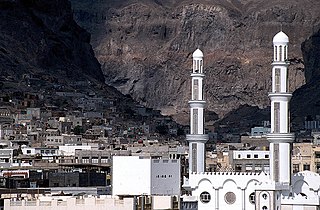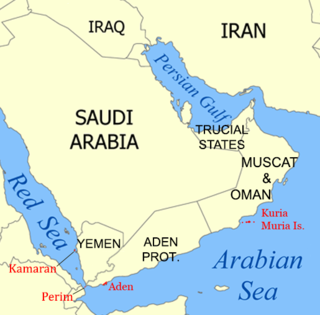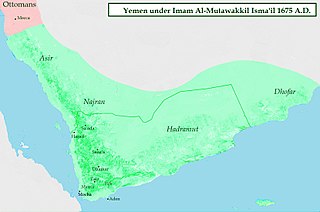
Yemen is one of the oldest centers of civilization in the Near East. Its relatively fertile land and adequate rainfall in a moister climate helped sustain a stable population, a feature recognized by the ancient Greek geographer Ptolemy, who described Yemen as Eudaimon Arabia, meaning "Fertile Arabia" or "Happy Arabia". The South Arabian alphabet was developed at latest between the 12th century BC and the 6th century AD, when Yemen was successively dominated by six civilizations that controlled the lucrative spice trade: Ma'in, Qataban, Hadhramaut, Awsan, Saba, and Himyar. With the 630 AD arrival of Islam, Yemen became part of the wider Muslim world, where it has remained.

Aden is a port city located in Yemen in the southern part of the Arabian peninsula, positioned near the eastern approach to the Red Sea. It is situated approximately 170 km east of the Bab-el-Mandeb strait and north of the Gulf of Aden. With its strategic location on the coastline, Aden serves as a gateway between the Red Sea and the Arabian Sea, making it a crucial maritime hub connecting Africa, Asia, and the Middle East. As of 2023, Aden City has a population of approximately 1,080,000 residents, making it one of the largest cities in Yemen. Aden is divided into eight districts: Tawahi, Mualla, Crater, Khur Maksar, Al Mansura, Dar Sad, Sheikh Othman, and Al Buraiqa. These form today's Aden Governorate. During the period of the British colonialism, Aden referred to the area along the north coast of the Gulf of Aden, encompassing Tawahi, Mualla, Crater, and much of Khur Maksar District. The western harbour peninsula, known as Little Aden, now falls within the Al Buraiqa District.

Yemen, officially the Republic of Yemen, is a country in West Asia. Located in southern Arabia, it borders Saudi Arabia to the north, Oman to the northeast, the Red Sea to the west, and the Indian Ocean to the south, sharing maritime borders with Eritrea, Djibouti and Somalia across the Horn of Africa. Covering roughly 455,000 square kilometres, with a coastline of approximately 2,000 kilometres, Yemen is the second largest country on the Arabian Peninsula. Sanaa is its constitutional capital and largest city. Yemen's estimated population is 34.7 million, mostly Arab Muslims. It is a member of the Arab League, the United Nations, the Non-Aligned Movement and the Organisation of Islamic Cooperation.

Yahya Muhammad Hamid ed-Din was the first king of the Mutawakkilite Kingdom of Yemen from 1918 until his assassination in 1948. He became Imam of the Zaydis, a branch of Shia Islam, in 1904 after the death of his father, Muhammad Al-Mansur, and Imam of Yemen in 1918. His name and title in full was "His Majesty Amir al-Mu'mimin al-Mutawakkil 'Ala Allah Rab ul-Alamin Imam Yahya bin al-Mansur Bi'llah Muhammad Hamidaddin, Imam and Commander of the Faithful".

Ahmad bin Yahya Hamidaddin was the penultimate king of the Mutawakkilite Kingdom of Yemen, who reigned from 1948 to 1962. His full name and title was H.M. al-Nasir-li-Dinullah Ahmad bin al-Mutawakkil 'Alallah Yahya, Imam and Commander of the Faithful, and King of the Mutawakkilite Kingdom of the Yemen.

The Kingdom of Yemen, officially the Mutawakkilite Kingdom of Yemen and also known simply as Yemen or, retrospectively, as North Yemen, was a state that existed between 1918 and 1970 in the northwestern part of the modern country of Yemen. Located in the Middle East, the Kingdom of Yemen had an area of 195,000 km2. The country was bordered by Saudi Arabia to the north, the Aden Protectorate to the south, and the Red Sea to the west. Its capital was Sanaa from 1918 to 1948, then Taiz from 1948 to 1962. Yemen was admitted to the United Nations on 30 September 1947. A republican coup was launched against the government in 1962, leading to the North Yemen Civil War. The royalist government only controlled the northern portions of the country from 1962 to 1970, until a peace deal in 1970 saw it largely dissolved.

The Aden Protectorate was a British protectorate in southern Arabia. The protectorate evolved in the hinterland of the port of Aden and in the Hadhramaut after the conquest of Aden by the Bombay Presidency of British India in January 1839, and which continued until the 1960s. In 1940, it was divided for administrative purposes into the Western Protectorate and the Eastern Protectorate. The territory now forms part of the Republic of Yemen.

Aden Colony was a crown colony of the United Kingdom from 1937 to 1963 located in the southern part of modern-day Yemen. It consisted of the port city of Aden and also included the outlying islands of Kamaran, Perim and the Khuria Muria archipelago with a total area of 192 km2 (74 sq mi). Initially a key port for the British East India Company, it was annexed by the British in 1839 to secure maritime routes and prevent piracy in the Arabian Sea. Its strategic position at the entrance to the Red Sea made it a vital stopover for ships traveling between Europe, India, and the Far East, especially after the opening of the Suez Canal in 1869. Aden quickly became a major coaling station and transit hub for British shipping, and its significance to the British Empire grew throughout the 19th and early 20th centuries.

Beihan or Bayhan, officially the Emirate of Beihan, was a state in the British Aden Protectorate and the Federation of South Arabia. Its capital was Suq Abdulla, now called Beihan. The Emirate was abolished in 1967 upon the founding of the People's Republic of South Yemen and is now part of the Republic of Yemen.

Yemen Region also known as South Arabia is a geographic term denoting territories of historic South Arabia which included All lands between the Gulf of Oman in the east and the Red Sea.

The Saudi–Yemeni war was a war between Saudi Arabia and the Kingdom of Yemen in 1934.

Islam came to Yemen around 630 during Muhammad's lifetime and the rule of the Persian governor Badhan. Thereafter, Yemen was ruled as part of Arab-Islamic caliphates, and became a province in the Islamic empire.

The Idrisid Emirate of Asir was a state located in the Arabian Peninsula. The Emirate was in the geographical region of Asir and Jizan, in what is now southwestern Saudi Arabia, and extending to Hodeidah, northwest of Yemen.
This is a survey of the postage stamps and postal history of Yemen.

The Yemen Eyalet was an eyalet (province) of the Ottoman Empire. Although formally an integral part of the empire, the far-flung province was notoriously difficult to administer, and was often lawless. During the early 17th century, the Eyalet was entirely lost to the Zaidi-ruled Qasimid State, only to be recovered by the Ottomans two centuries later. The Yemen Eyalet was reorganized in 1849, upon Ottoman takeover of much of Greater Yemen territories. In 1872, most of it became Yemen Vilayet after a land reform in the empire.

Yemen Vilayet was a first-level administrative division (vilayet) of the Ottoman Empire. At the beginning of the 20th century it reportedly had an area of 200,000 square kilometres (77,200 sq mi). The population for the vilayet is given by the 1885 Ottoman census as 2,500,000.
The al-Waziri coup, also known as the al-Dostour Revolution also the Yahya clan coup, was a violent dynasty overthrow attempt in the Kingdom of Yemen in 1948, which caused around 5,000 fatalities. During the coup attempt, Imam Yahya Muhammad Hamid ed-Din, the ruler of the kingdom, was killed and the rival Sayyid family, the al-Wazirs, seized power for several weeks. Backed by the al-Saud family of Saudi Arabia, the Hamidaddins restored their rule. After the al-Wazirs were deposed, Imam Yahya's monarchy was restored with his son, Ahmad bin Yahya, ascending the throne.

Italy–Yemen relations refers to the current and historical relationship between Italy and Yemen. Yemen has an embassy in Rome. Italy had an embassy in Sana'a, which was closed in 2015 due to concerns over security and the withdraw of staff.

Slavery in Yemen was formally abolished in the 1960s. However, it has been reported that enslavement still occurred in the 21st-century.

The Saudi Arabia–Yemen border is 1,307 km (812 mi) in length and runs from the Red Sea coast in the west to the tripoint with Oman in the east.

















